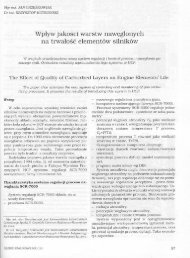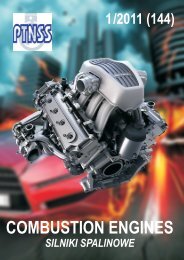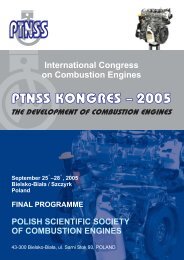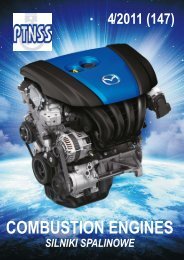Create successful ePaper yourself
Turn your PDF publications into a flip-book with our unique Google optimized e-Paper software.
Badania symulacyjne wpływu nieszczelności układów dolotowych turbosprężarek na ich skuteczność działania<br />
a) b)<br />
Fig. 12. Deformed turbine vanes: a) scale 1:1, b) scale 4:1<br />
Rys. 12. Zdeformowane łopatki turbiny: a) skala 1:1, b) skala 4:1<br />
The most conspicuous effect of the damage of the turbocharger<br />
is the breaking of the shaft. It happened as a result of the<br />
increasing shaft vibration amplitude, resonance or a growth in<br />
the fatigue-related tensions. The shaft broke at a point where it<br />
cooperated with the transverse bearing where the cross-section<br />
changed (the effect of the notch). Figure 11 shows the surface<br />
of the shaft breaking spot. We can see the<br />
fatigue-related relative displacements of<br />
the material. The surface of the breaking<br />
spot is polished which proves that the<br />
broken parts of the shaft were in direct<br />
contact. We can suppose that the turbine<br />
part of the shaft rotated and the compressor<br />
part of the shaft was stationary. Under<br />
such conditions engine supercharging<br />
was impossible.<br />
The breaking of the shaft led to<br />
further damage such as turbine vane<br />
deformation (Fig. 12). The deformation<br />
resulted from the collision of the<br />
vanes with the turbine shroud. The deformations<br />
within the vanes, as shown<br />
in Fig. 12 prove a modification of the<br />
material properties due to excessive<br />
temperature (above the point of eutectic<br />
transformation in steel). The growth in<br />
the temperature was caused by friction<br />
between the vanes and the shroud in the<br />
presence of exhaust gases.<br />
In the part of the broken shaft on the<br />
side of the turbine, beside the damaged<br />
vanes an extensive local wear of the<br />
ring surface was observed (Fig. 13).<br />
This confirms that despite the breaking<br />
of the shaft exhaust gases still propelled<br />
the turbine impeller.<br />
This phenomenon is also seen on the<br />
part of the sleeve of the slide bearing<br />
that cooperated with the broken shaft<br />
(Fig. 14). We can see denting of the<br />
sleeve in the contact area.<br />
z korpusem turbiny. Zniekształcenia<br />
w obrębie łopatki turbiny, przedstawione<br />
na rys. 12, świadczą o zmianie<br />
właściwości fizycznych materiału na<br />
skutek zbyt wysokiej temperatury<br />
(powyżej przemiany eutektycznej w<br />
stali). Wzrost temperatury spowodowany<br />
był tarciem łopatek o korpus<br />
turbiny w obecności gorących gazów<br />
spalinowych.<br />
W części urwanego wału po stronie<br />
turbiny oprócz zniekształconych<br />
łopatek zaobserwowano rozległe<br />
wytarcie powierzchni pierścieniowej<br />
(rys. 13). Potwierdza to, że mimo<br />
rozerwania wału na wirnik turbiny<br />
w dalszym ciągu trafiały gazy spalinowe.<br />
Zjawisko to widoczne jest także na części tulei łożyska<br />
ślizgowego, która współpracowała z zerwanym wałem (rys.<br />
14). Zaobserwować można wyszczerbienie tulei w obszarze<br />
kontaktu z wałem.<br />
a) b)<br />
Fig. 13. The ring part: a) damaged element – scale 1:1, b) new element – scale 4:1<br />
Rys. 13. Część pierścieniowa: a) element uszkodzony – skala 1:1, b) element nowy – skala 4:1<br />
a) b)<br />
Fig. 14. Damaged transverse bearing: a) scale 2:1, b) scale 10:1<br />
Rys. 14. Uszkodzone łożysko poprzeczne: a) skala 2:1, b) skala 10:1<br />
70 <strong>COMBUSTION</strong> <strong>ENGINES</strong>, No. 4/2012 (151)












